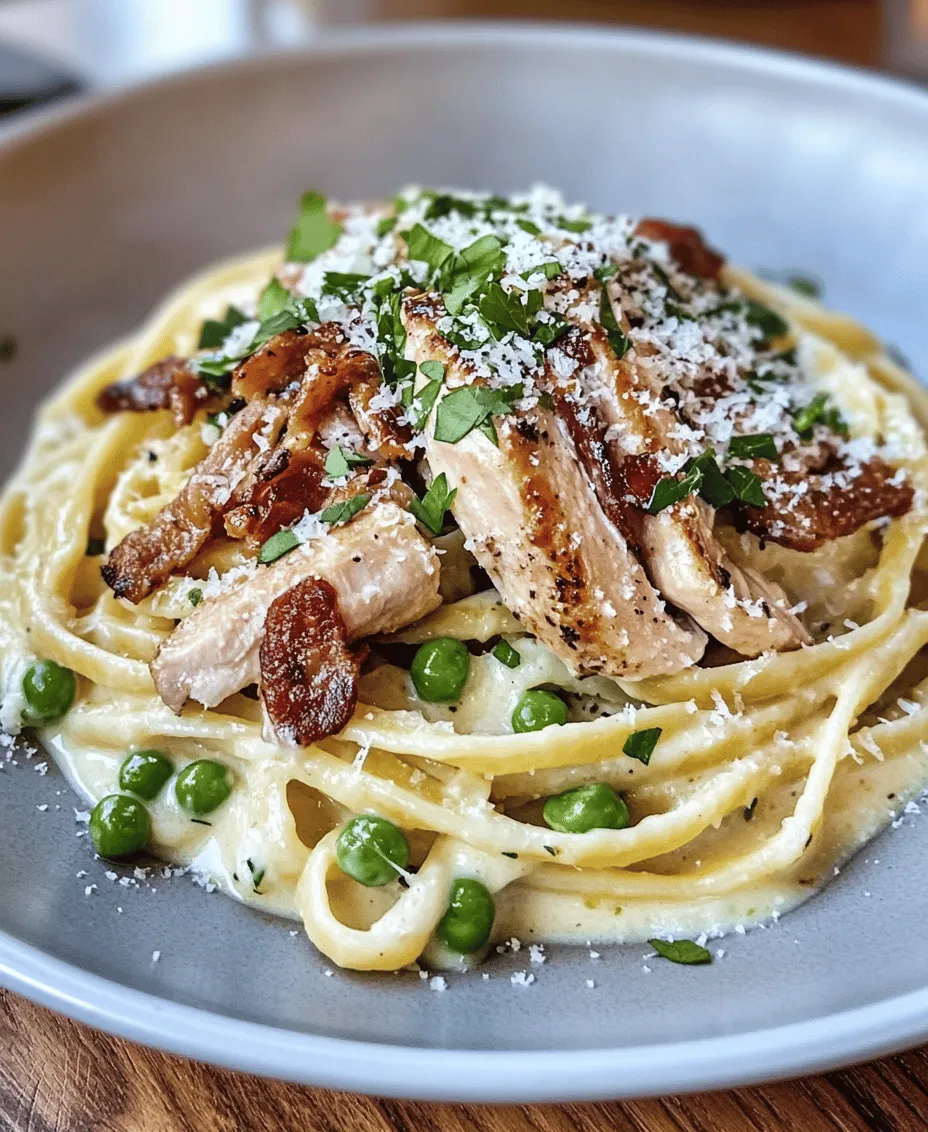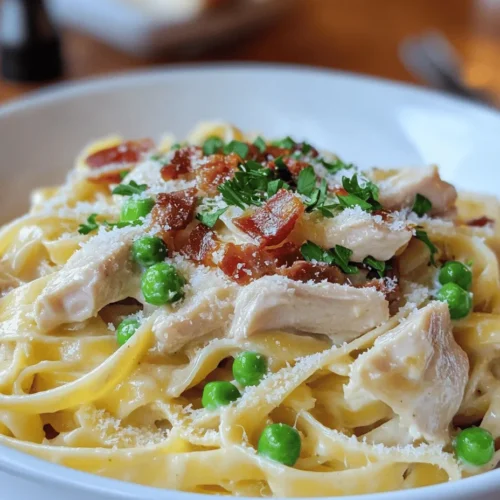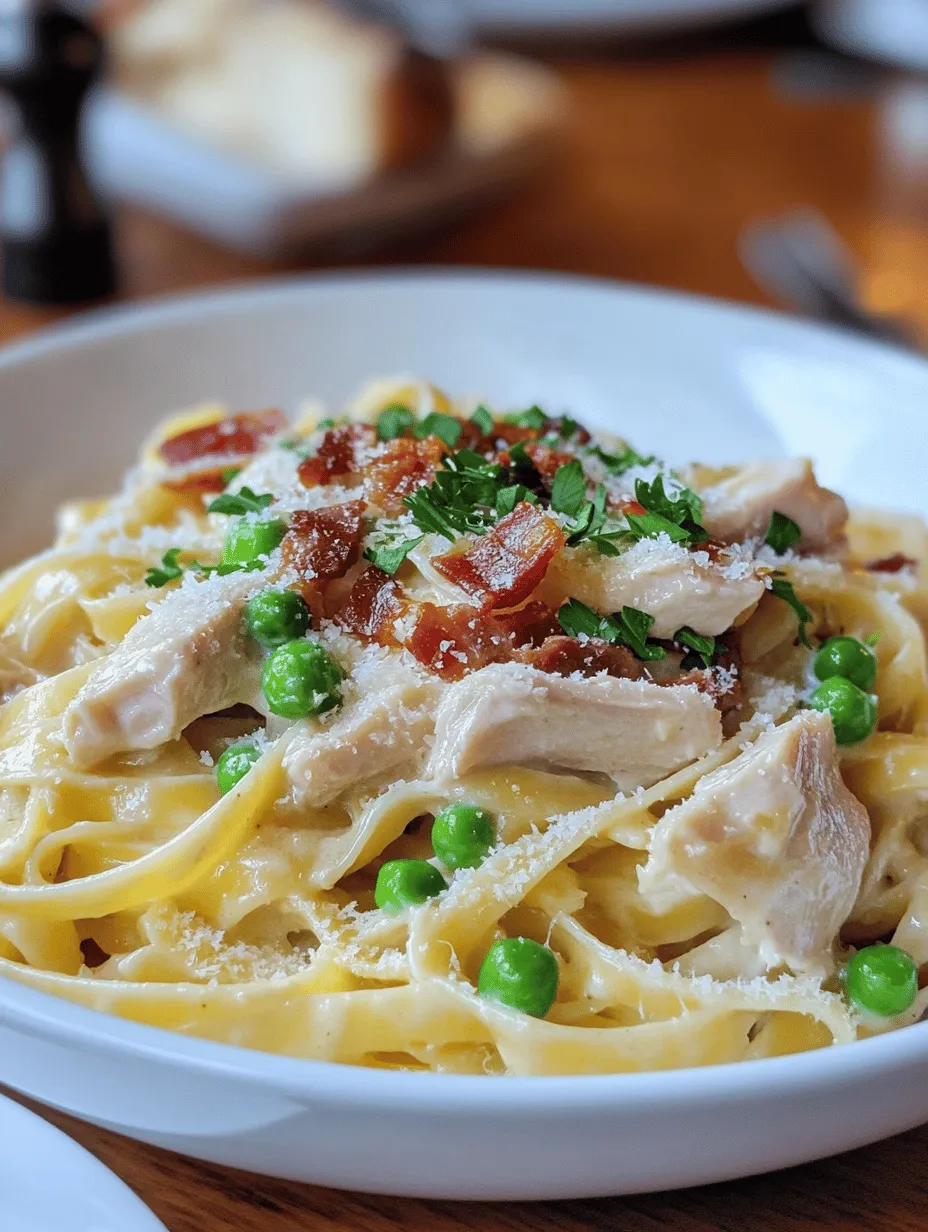Introduction
Chicken Carbonara is a culinary masterpiece that captures the essence of Italian comfort food. This dish, known for its rich and creamy sauce, tender chicken, and savory pancetta, has won hearts around the world. It is not just a meal; it’s an experience—one that invites you to savor every bite while enjoying the delightful textures and flavors that unfold with each forkful. Whether you’re cooking for a family dinner, a romantic evening, or simply treating yourself to something special, Chicken Carbonara is sure to impress.
The origins of Carbonara trace back to the mid-20th century in Rome, where it was traditionally made with guanciale (cured pork cheek), eggs, and Pecorino Romano cheese. The dish’s simplicity and reliance on quality ingredients have made it a staple in Italian cuisine. While traditional recipes vary, the heart of Carbonara remains the same: a creamy sauce that clings to the pasta, creating a satisfying and indulgent experience. In this recipe, we’ll incorporate boneless chicken breasts to add a protein-rich element, making it a complete meal that is both hearty and comforting.
When it comes to creating the best Chicken Carbonara, the quality of your ingredients is paramount. Using fresh, high-quality products not only enhances the flavor but also elevates the overall dish, turning a simple recipe into a restaurant-quality meal. From the pasta to the cheese, each component plays a crucial role, and understanding their importance will help you achieve that perfect creamy consistency and robust flavor.
Understanding the Ingredients
Before diving into the cooking process, it’s essential to familiarize yourself with the key ingredients that will bring this Chicken Carbonara to life. Each element contributes to the overall taste and texture, so let’s break them down.
Fettuccine or Spaghetti: Choosing the Right Pasta for Carbonara
The choice of pasta is fundamental in any Carbonara recipe, and while spaghetti is the traditional option, fettuccine has gained popularity for its wider surface area, allowing it to hold onto the creamy sauce better. Both options have their merits, and the decision ultimately comes down to personal preference. Spaghetti offers a classic approach, while fettuccine provides a more luxurious mouthfeel. Whichever you choose, aim for high-quality pasta made from durum wheat for the best results.
Chicken: Benefits of Using Boneless, Skinless Chicken Breasts
Incorporating chicken into your Carbonara not only boosts the protein content but also adds a satisfying texture that complements the creamy sauce. Boneless, skinless chicken breasts are ideal for this dish as they cook quickly and evenly. They can easily absorb the flavors of the sauce while remaining juicy and tender. For added flavor, consider marinating the chicken briefly before cooking, enhancing its taste and ensuring it pairs beautifully with the other ingredients.
Pancetta or Bacon: Differences and Flavor Profiles
Pancetta, an Italian cured meat made from pork belly, is the traditional choice for Carbonara. It provides a rich, savory flavor that is essential for the dish. However, if you can’t find pancetta, high-quality bacon can be a suitable substitute. The main difference lies in the curing process; pancetta is salt-cured and aged, while bacon is typically smoked. This results in a slightly different flavor profile, with pancetta offering a more delicate taste, while bacon brings a smokier essence. Whichever option you choose, the fat rendered during cooking will contribute to the creamy sauce.
Pecorino Romano Cheese: Importance in Achieving Creaminess
Pecorino Romano cheese is the quintessential cheese for Carbonara. This hard, salty cheese made from sheep’s milk adds a sharp, tangy flavor that balances the richness of the other ingredients. Freshly grated Pecorino Romano not only enhances the creaminess of the sauce but also gives it a distinct character that is characteristic of authentic Carbonara. Avoid pre-grated cheese, as it often contains anti-caking agents that can affect the sauce’s texture.
Eggs: The Key to the Carbonara Sauce
Eggs are the heart of Carbonara sauce, providing creaminess without the need for heavy cream. The combination of egg yolks and whole eggs creates a velvety sauce that clings to the pasta beautifully. The key is to add the eggs to the pasta while it’s hot, allowing them to cook gently and emulsify with the cheese and pasta water, creating a rich, luxurious sauce. It’s essential to use fresh eggs for the best flavor and texture.
Garlic: Enhancing the Overall Flavor
While not a traditional ingredient in Carbonara, garlic can enhance the overall flavor profile of the dish. Incorporating minced garlic during the sautéing process adds depth and aroma, complementing the savory notes of the pancetta and chicken. It’s important to sauté the garlic briefly to avoid bitterness, ensuring it infuses the dish without overpowering the other flavors.
Optional Ingredients: Peas and Their Contribution to the Dish
For those who enjoy a touch of sweetness and color in their Carbonara, adding peas can be a delightful option. Fresh or frozen peas can be stirred into the dish towards the end of cooking, adding a pop of freshness and a vibrant green hue. They not only provide a nutritional boost but also create a lovely contrast to the rich, creamy sauce.
Step-by-Step Cooking Instructions
Now that you’re familiar with the ingredients, it’s time to dive into the cooking process. Preparing Chicken Carbonara is straightforward, but attention to detail is crucial to achieving the best results. Follow these step-by-step instructions to create your own delicious Carbonara.
Detailed Preparation of the Pasta
1. Boil the Water: Start by bringing a large pot of salted water to a rolling boil. Use about 1 tablespoon of salt for every 4-6 quarts of water. This seasoning is essential as it will flavor the pasta as it cooks.
2. Cook the Pasta: Add your chosen pasta (fettuccine or spaghetti) to the boiling water and cook according to the package instructions until al dente. Al dente pasta should be firm to the bite, as it will continue to cook slightly when mixed with the sauce.
3. Reserve Pasta Water: Before draining the pasta, reserve about 1 cup of the pasta water. This starchy water is crucial for adjusting the sauce’s consistency and ensuring it clings to the pasta perfectly.
Cooking the Chicken
1. Season the Chicken: While the pasta cooks, season the boneless, skinless chicken breasts with salt and pepper. For added flavor, consider sprinkling garlic powder or Italian seasoning.
2. Heat the Skillet: In a large skillet over medium-high heat, add a drizzle of olive oil. Once hot, place the chicken breasts in the skillet, ensuring they are not overcrowded.
3. Sauté the Chicken: Cook the chicken for about 5-7 minutes per side, or until it reaches an internal temperature of 165°F (75°C) and is golden brown. Remove the chicken from the skillet and let it rest for a few minutes before slicing it into bite-sized pieces.
Preparing the Pancetta or Bacon
1. Render the Fat: In the same skillet used for the chicken, add the diced pancetta or bacon. Cook over medium heat, stirring occasionally, until it’s crispy and has rendered its fat, about 4-5 minutes.
2. Add Garlic: Once the pancetta or bacon is crispy, add minced garlic to the skillet and sauté for an additional 30 seconds. Be careful not to let it burn, as burnt garlic can impart a bitter taste.
With these foundational steps in place, you are well on your way to creating an unforgettable Chicken Carbonara. The combination of tender chicken, crispy pancetta, and a rich, creamy sauce will soon come together to create a dish that is sure to impress. Stay tuned for the continuation of the recipe, where we’ll dive into the final steps of combining all the elements and achieving that perfect creamy finish.

Achieving Optimal Crispiness
To achieve that perfect crispiness in your Chicken Carbonara, start by ensuring your chicken is patted dry before cooking. Excess moisture can lead to steaming rather than searing. Use a large skillet over medium-high heat and add a generous amount of olive oil. When the oil shimmers, carefully add the chicken pieces. Avoid overcrowding the pan; this helps to create a golden crust. Cook the chicken for about 5-7 minutes on each side, or until it’s golden brown and cooked through. The key here is to let the chicken sit undisturbed for the first few minutes to allow a crust to form before flipping.
Timing the Addition of Garlic for Maximum Flavor
Garlic can easily overpower the dish if added too early. For Chicken Carbonara, timing is everything. Once the chicken is cooked and removed from the skillet, reduce the heat to medium. In the residual oil, add minced garlic and sauté for about 30 seconds until fragrant. This method ensures the garlic retains its sweetness and does not burn, which can introduce bitterness into your sauce.
Creating the Creamy Sauce
The creamy sauce is the heart of Chicken Carbonara. Start by whisking together the eggs, grated Parmesan cheese, and a generous amount of black pepper in a separate bowl. This mixture is what will transform the dish from a simple pasta into a luxurious meal. The heat from the pasta will cook the eggs gently, creating a creamy consistency without scrambling them.
Whisking Techniques for Eggs and Cheese
To achieve the ideal texture for your sauce, use a whisk rather than a fork. Whisking incorporates air, ensuring a smooth and creamy sauce. Begin by cracking the eggs into a mixing bowl, then slowly add the grated cheese while whisking continuously. This technique helps the cheese melt into the warm eggs, creating a cohesive mixture. Ensure there are no lumps for the best result.
Balancing Seasoning for the Sauce
Seasoning is crucial for enhancing the flavor of your Chicken Carbonara. While the cheese adds saltiness, it’s essential to taste and adjust before combining it with the pasta. The black pepper should be freshly cracked to bring out its full flavor. A pinch of salt can also be added to enhance the overall taste, but remember that too much can overpower the dish.
Combining All Components
Once your pasta is al dente, it’s time to combine all the components. Drain the pasta but reserve about a cup of the pasta water. In a large bowl or pot, combine the hot pasta with the egg and cheese mixture, stirring quickly to coat the pasta without scrambling the eggs. The heat from the pasta will begin to cook the eggs, creating that creamy texture. If the sauce is too thick, gradually add reserved pasta water until you reach your desired consistency.
Importance of Heat Control in Mixing Ingredients
Heat control is vital when mixing the ingredients. You want the pasta warm enough to cook the eggs gently but not so hot that it scrambles them. If you find the sauce is becoming too thick or the eggs are beginning to cook too quickly, remove the pot from the heat while mixing. This will help maintain a creamy consistency.
Adjusting Consistency with Pasta Water
Pasta water is a secret weapon in achieving the perfect sauce consistency. The starchy water helps to emulsify the sauce, resulting in a silky finish. As you mix the pasta with the sauce, slowly add in small amounts of pasta water until you achieve your preferred creaminess. The sauce should cling to the pasta without being overly runny.
Final Touches: Adding Chicken and Peas
Once the pasta is coated in the creamy sauce, it’s time to add the chicken and peas. Fold the cooked chicken into the pasta gently to ensure even distribution. Then, add in the peas, which will add a pop of color and sweetness to the dish. Stir until everything is well combined and heated through.
Ensuring Even Distribution of Flavors
To ensure that every bite of your Chicken Carbonara is bursting with flavor, make sure to taste as you go. Adjust the seasoning if necessary by adding more cheese, pepper, or a sprinkle of salt. A gentle toss of the pasta will help distribute the chicken, peas, and sauce evenly, allowing each component to shine.
—
Serving Suggestions
Plating the Chicken Carbonara for Presentation
Presentation plays a significant role in enjoying your meal. When plating your Chicken Carbonara, use a large pasta fork to twirl the spaghetti into a nest shape in the center of the plate. This not only looks visually appealing but also allows for a generous portion. You can sprinkle extra Parmesan cheese on top and add a few peas for a pop of color.
Recommended Garnishes and Their Impact on Flavor
Garnishing can elevate your Chicken Carbonara from ordinary to extraordinary. A sprinkle of freshly chopped parsley adds a vibrant color and fresh flavor that cuts through the richness of the dish. Additionally, a light dusting of extra black pepper can enhance the overall taste. For those who enjoy a bit of heat, consider adding red pepper flakes for an extra kick.
Pairing Suggestions
Pairing your Chicken Carbonara with the right beverage and side dishes can enhance the entire dining experience. A crisp white wine, such as a Pinot Grigio or a light Chardonnay, complements the creamy sauce beautifully. For side dishes, a simple arugula salad dressed with lemon vinaigrette adds a refreshing contrast to the richness of the carbonara. Garlic bread is also a popular choice, providing a perfect accompaniment for mopping up the creamy sauce.
—
Nutritional Information
Breakdown of Calories, Protein, Fats, and Carbohydrates Per Serving
Understanding the nutritional aspects of your Chicken Carbonara can help maintain a balanced diet. A typical serving of Chicken Carbonara (approximately 1 cup) contains about:
– Calories: 500
– Protein: 30g
– Fats: 20g
– Carbohydrates: 55g
This breakdown makes it a hearty meal that offers a good source of protein and carbohydrates, perfect for refueling after a long day.
Benefits of the Ingredients in the Context of a Balanced Diet
The ingredients used in Chicken Carbonara provide various health benefits. Chicken is an excellent source of lean protein, essential for muscle repair and growth. Eggs are packed with vitamins and minerals, including vitamin D and B12, which are crucial for maintaining energy levels. Whole grain pasta can offer additional fiber, aiding in digestion and providing sustained energy. Peas add a boost of vitamins A and C, contributing to overall health.
—
Conclusion
In summary, the Best-Ever Chicken Carbonara is a delightful dish that combines creamy textures, savory flavors, and hearty ingredients into one satisfying meal. The ease of preparation, combined with the ability to customize ingredients, makes this recipe a staple for both weeknight dinners and special occasions. Don’t hesitate to experiment with varieties, whether it’s adding seasonal vegetables or swapping in different proteins.
The joy of homemade pasta dishes like Chicken Carbonara lies not only in their deliciousness but also in their ability to bring family and friends together. Enjoy the process of creating this classic dish, and take pride in serving a meal that’s comforting, flavorful, and sure to impress.



